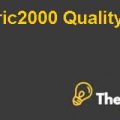
Current Financial Policies
However, until 1980s, General Motor financial policies were developed in order to ensure that the business conduct generates sufficient and stable cash flows.Meanwhile, the policies were directed towards the provision of support and to facilitate the existing product plans as well as to support the new product plans. Additionally, the policies also supported the strategic initiatives taken from time to time for the achievement of organizational goals and objectives. Moreover, the financial policies included the setting up of goals and targets relating to the financial management activities that are key to the financial risk management. However, these financial management activities included the management of appropriate level of debt to equity ratio, management of financial risk, management of sufficient levels of cash balances in order to avoid liquidity issues, deciding upon the appropriate policy for the dividend distribution and the structure of liability.
In addition to the financial policies General Motors’ liability management policies did not include the use of financial derivatives for the management of interest rate liabilities. However, the interest rate liabilities were managed under the matching principle that required General Motors to manage and generate sufficient revenues and cash flows so that the changes in interest rate liabilities can be set off by the effective management of revenues and cash flow from the business operations. Further, the interest rate liabilities were managed through altering the liability portfolio in order to match the overall liability portfolio in accordance with the movements in interest rates over a period of time. However, the policies were directed to reduce the interest rate risk exposure so that the interest expenses can be reduced to a possibly low level.
Dilemma
General Motors wants to raise $400 million through issue of non-callable five years note to the general public at a fixed coupon rate of 7.625%. However, Stephane Bello, financial analyst at General Motors, is in a dilemma where he has to recommend General Motor regarding the selection of appropriate transaction in order to reduce the interest cost. Stephane is a newly hired financial analyst and he joined General Motors one years ago and is expected to use his past experience of commercial bank in order to reduce the interest rate exposure at General Motors. Stephan knows that he will have to use the financial derivative and hedging instruments in order to reduce the interest expense and the potential interest rate exposure. He has four options available to him, do nothing, interest rate swaps, caps, treasury options and swaptions (options on swaps) out of which he has to decide the best alternate for hedging General Motors position against interest rate exposure.
Analysis
Do Nothing
However, do nothing alternative involves the issuance of notes to the general public at a coupon rate of 7.625% for a period of five years. However, due to the underwriter’s issuance cost and other expenses effective interest rate would increase to 7.752%. Further, this alternate would fix the interest rates at the effective interest rate of 7.752%, meanwhile, General Motors will not be able to reduce its interest cost incase if future interest rates decreases.
Interest Rate Swaps
Hedging the interest rate exposure through the use of interest rate swaps will involve General Motor in arrangement with a third party for the simultaneous exchange of fixed and floating interest rates. Moreover, since General Motors is concerned about the future interest rates and expects that the interest rate will probably decline in future, therefore, it wants to exchange the fixed interest rate with a floating interest rate. However, as per the results of interest rate swaps alternate, it is probable that the use of interest rate swap would not reduce the interest rate expenses, because six months LIBOR rate hasto be at 3.56% or at a lower rate, which is currently at 4.31%. Therefore, the use of interest rate swap would not protect the fix the interest rate exposure, meanwhile, it will not fix the interest rates nor it would reduce the interest rate expense.
Caps
Another hedging instrument that is available to Stephan is the use of caps in order to hedge General Motors interest rate exposure. The use of caps will fix the upper limit on interest rate, which means that if the interest rates were to increase above a certain limit, then this increase will not increase the interest rates for the party who has purchased the cap. Since General Motors expects the interest rates to decrease in the future, therefore, under this alternate, General Motor can sell the interest rate caps and in exchange of selling the interest rate caps General Motors will get the premium on selling the interest rate caps. Further, the proceeds from selling the interest rate caps will be used to compensate the interest expenses and will decrease the effective interest rate.
Meanwhile, if General Motors sells an interest rate cap at an exercise price of 9% it will receive a premium of $8.52 million...............
This is just a sample partial case solution. Please place the order on the website to order your own originally done case solution.
Analyst at General Motors, responsible for managing the debt structure automaker must decide whether and how to change the interest rate exposure last sentence debts of company. The analyst must take into account the responsibility of managing the GM guidelines, the existing interest rate exposure of the company, its expectations of interest rates, and a wide range of interest rate products. He must decide whether to leave the fixed-rate instrument unchanged or to make a swap, cap, interest rate option, or swap option. "Hide
by Peter Tufano Source: Harvard Business School 18 pages. Publication Date: March 24, 1993. Prod. #: 293123-PDF-ENG













